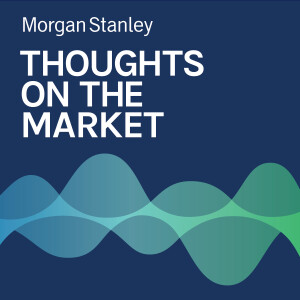
Our Head of Europe Thematic Research discusses revolutionary “Longshot” technologies that can potentially alter the course of human ageing, and which of them look most investible to the market.
----- Transcript -----
Welcome to Thoughts on the Market. I’m Ed Stanley, Morgan Stanley’s Head of Thematic Research in London. Along with my colleagues bringing you a variety of perspectives, today I’ll discuss the promise of technology that might help us live longer and better lives.
It’s Friday, the 26th of April, at 2pm in London.
You may have heard me discuss Moonshots and Earthshots on this podcast before. Moonshots are ambitious solutions to seemingly insurmountable problems using disruptive technology, predominantly software; while Earthshots, by contrast, are radical planet-focused technologies to accelerate decarbonization and mitigate global warming, predominantly hardware challenges.
But today I want to address a third group of revolutionary solutions that I call Longshots. These are the most promising Longevity technologies. And in terms of the three big secular themes that Morgan Stanley is focused on – which are Decarbonization, Tech Diffusion, and Longevity – Longshots straddle the latter two.
Unlike software-based Moonshots or hardware-based Earthshots, these Longshots face some of the greatest challenges of all. First, we know remarkably little about the process of ageing. Second, these are both hardware and software problems. And third, the regulatory hurdles are far more stringent in healthcare, when compared to most other emerging technology fields.
We believe the success of Longshots depends on a deep understanding of Longevity. And loosely speaking, you can think of that as a question of whether someone's phenotype can outweigh their genotype. In other words, can their lifestyle, choices, environment trump the genetics that are written into their DNA.
Modern medicine, by focusing almost exclusively on treating disease rather than preventing it, has succeeded in keeping us alive for longer – but also sicker for longer. Preventing disease increases our health spans and reduces morbidity, and its associated costs.
So, in this regard, can we learn anything from the centenarians - the people who live to a hundred and beyond? They number around 30 people in every 100,000 of the population. And many of them live healthy lives well into their eighties. And what makes them so rare is they are statistically better at avoiding what the medical industry calls the Four Horsemen: coronary disease, diabetes, cancer and Alzheimer’s. So, can Longshots help to replicate that successful healthy ageing story for a larger slice of the population?
We look to technology for ways to delay the onset of these chronic diseases by 10 to 30 years, giving healthy life extension for all. That’s not an outlandish goal in theory; but in practice we need a new approach to medical research. And we will be watching how the ten key Longshots we have identified play into this.
Two of these Longshots are already familiar to our listeners: Diabesity medication and Smart Chemotherapy treatments, with a combined addressable market – according to our analysts – of a quarter of a trillion dollars. The other eight Longshots include AI-enabled drug discovery, machine vision embryo selection dramatically increasing the odds of fertility via IVF, bioprinting of organs, brain-computer Interfaces, CRISPR, DNA synthesis, robotics and psychedelics.
In assessing the maturity and investibility of these ten Longshots, we find that obesity medication, smart chemo, and AI-assisted drug discovery are better understood by the market and look more investible. Many of the others are seeing material outcome- and cost-improvements but they remain earlier-stage, more speculative, particularly for public market investors.
In contrast to Moonshots and Earthshots, where venture investors make up the lion's share of most of the early-stage capital, Longshots have substantially higher exposure to government agencies that make investments in early-stage healthcare projects. Governments are making hundreds of bets on Longshots in searches for solutions to reduce overall healthcare spending – or at the very least get a better return on that investment – which in 2023 amounted to $4.5 trillion in the US, and a whopping $10 trillion globally.
Clearly, the stakes are very high, and the market opportunity is vast, particularly as AI technologies advance in tandem. And so, we’ll keep you updated on the promise of these Longshots.
Thanks for listening. If you enjoy the show, please leave a review and share Thoughts on the Market with a friend or a colleague today.
More Episodes
 2024-09-13
2024-09-13
 2024-09-12
2024-09-12
 2024-09-11
2024-09-11
 2024-09-10
2024-09-10
 2024-09-09
2024-09-09
 2024-09-05
2024-09-05
 2024-09-04
2024-09-04
 2024-09-03
2024-09-03
 2024-08-29
2024-08-29
 2024-08-28
2024-08-28
 2024-08-27
2024-08-27
 2024-08-26
2024-08-26
 2024-08-23
2024-08-23
 2024-08-22
2024-08-22
 2024-08-19
2024-08-19
 2024-08-16
2024-08-16
Create your
podcast in
minutes
- Full-featured podcast site
- Unlimited storage and bandwidth
- Comprehensive podcast stats
- Distribute to Apple Podcasts, Spotify, and more
- Make money with your podcast
It is Free
- Privacy Policy
- Cookie Policy
- Terms of Use
- Consent Preferences
- Copyright © 2015-2024 Podbean.com





